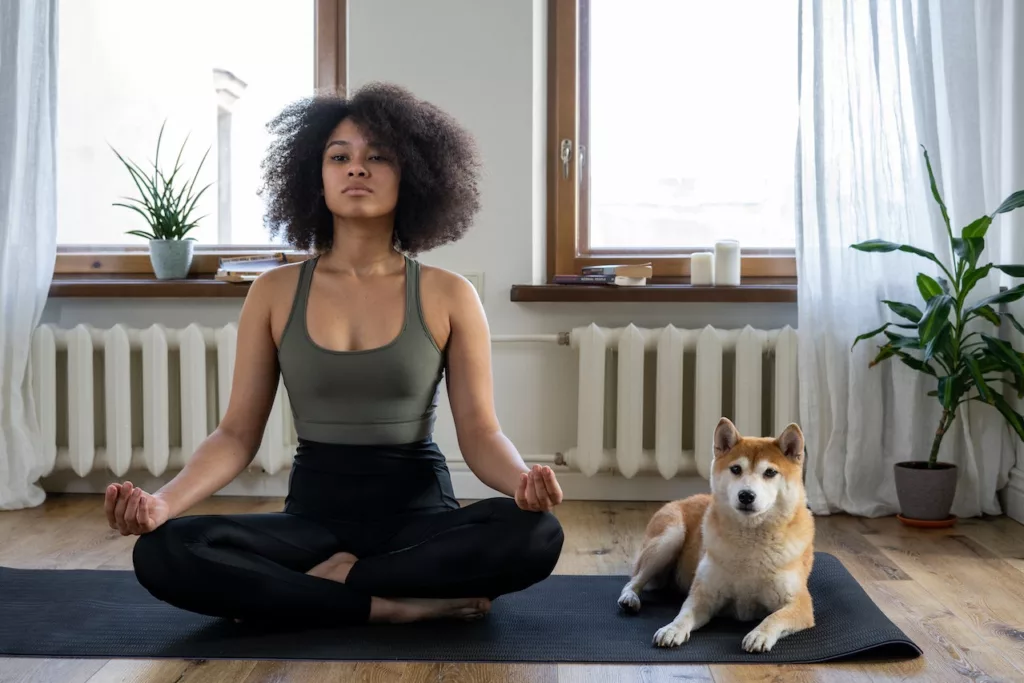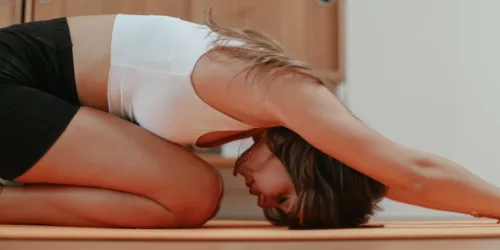Restorative Yoga Poses for Anxiety

Peaceful poses and purposeful breathing can create a calming, compassionate connection with our body and mind. We invite you to join us on a journey to explore the power of restorative yoga poses for anxiety.
Through this practice, we’ll learn how to use gentle stretches and mindful movements to ease into a deep sense of inner peace and relaxation.
Together, let’s discover how this ancient art can help us reduce stress, improve moods, and cultivate an overall sense of wellbeing.
Key Takeaways
- Restorative yoga is a practice designed to help relax and reduce anxiety.
- It involves mindful breathing and gentle poses held for longer periods of time.
- Props like bolsters, blankets, and blocks are used for support.
- Restorative yoga poses have a calming effect on anxiety and help release physical tension and mental stress.
What Is Restorative Yoga
Restorative yoga is a practice designed to help you relax and reduce your anxiety. It involves mindful breathing and gentle poses that are held for longer periods of time, allowing the body to sink into a deep state of relaxation.
During restorative yoga, we focus on energy healing and calming our minds so that we can tap into our inner wisdom and connect with ourselves on a deeper level. We use props such as bolsters, blankets, and blocks to support us in each pose while we let go of physical tension and mental stress.
Restorative yoga helps us feel more grounded and connected to our bodies while also helping to release any negative emotion or energy buildup. With regular practice, it can be an effective tool in managing anxiety levels over time.
Benefits of Restorative Yoga for Anxiety
We’re here to talk about the amazing benefits of Restorative Yoga for anxiety.
The calming effects of this practice can be truly remarkable, helping us to reduce our stress levels and improve our sleep.
This gentle form of yoga allows us to slow down and find balance in a safe, supportive environment, leaving us feeling more relaxed and at ease with ourselves and the world around us.
Calming Effects
Restorative yoga poses can have a calming effect on anxiety. They achieve this through mindfulness techniques, physical relaxation, and gentle stretching. These poses provide relief from the physical and mental stress of anxiety.
Here are four ways restorative yoga might help:
- It encourages you to take time for yourself.
- It cultivates inner peace.
- It reduces muscle tension caused by stress.
- It helps you get in touch with your body.
Restorative yoga is an excellent way to quiet your mind and focus on being present in the moment. It allows you to let go of worries about the past or future. When practiced regularly, restorative yoga can bring balance and harmony back into your life. It provides an outlet for stress relief and relaxation.
Stress Reduction
By focusing on the present moment and practicing mindfulness techniques, you can reduce stress levels through restorative yoga.
Through body awareness and a mind-body connection, this type of yoga helps to reduce tension and relax the mind.
It is an effective way to focus energy on breathing deeply and being in control of your body’s movements.
Restorative poses are designed to help calm the nervous system while releasing tightness in the muscles, which helps to bring about a feeling of peace.
These poses help promote relaxation by using props such as blankets and blocks that allow for deeper stretching with less effort for more comfort.
Improved Sleep
Practicing restorative yoga can help improve your sleep quality by calming the nervous system and releasing tightness in the muscles, allowing for a more relaxed state of being. Incorporating meditation music with simple poses like legs up the wall or child’s pose can reduce anxiety and improve sleep quality.
Here are four ways to incorporate restorative yoga into your nightly routine:
- Spend five minutes listening to relaxation music before bed.
- Take deep breaths while in supported postures such as Reclined Bound Angle Pose.
- Hold gentle stretches for 3-5 minutes to release tension from the day.
- Make time for a short guided meditation at night before sleeping.
Restorative yoga is an effective way to find relief from insomnia and other stress-related conditions that might be keeping you awake at night. Allowing yourself some quiet time each night can have a powerful impact on improving your overall health and well-being.
Guidelines for Practicing Restorative Yoga

To effectively reduce anxiety, it’s important to follow certain guidelines when practicing restorative yoga.
Being mindful of our breathing and muscle relaxation can help create a sense of calmness throughout the body.
It is also important to be patient with ourselves; while it may take some time for us to feel the desired effect, we should not give up.
Additionally, find a comfortable position that allows us to relax completely and stay in that pose for an extended period of time.
Lastly, it helps to focus on how our body feels as opposed to what thoughts are running through our minds.
With these guidelines in mind, we are ready to move on to exploring top restorative poses for anxiety.
Top Restorative Poses for Anxiety
We understand that suffering from anxiety can be a difficult experience. That’s why we’ve compiled some of the top restorative poses for anxiety to help you find relief.
Restorative yoga is beneficial in reducing stress and calming the body, mind, and heart, while providing relief from different types of anxieties. Through relaxation techniques and breath work, these poses will help you access your inner peace and restore balance in your life.
Benefits of Restorative Yoga
We all experience anxiety. Restorative yoga offers many benefits for reducing it, such as calming the mind and body.
Here are four of them:
- Enhanced mood: Practicing restorative yoga can help boost your mood by releasing feel-good hormones and giving you a sense of accomplishment when completing poses.
- Calmness: By focusing on mindful breathing, restorative yoga gives you an opportunity to let go of distracting thoughts and find peace within yourself.
- Relieves stress: Through its gentle movements, restorative yoga reduces tension in the body and helps you relax both physically and mentally.
- Promotes self-awareness: It encourages you to be more aware of your emotions, allowing you to understand how they affect your physical and mental health.
Restorative yoga is a powerful tool that can help ease anxiety symptoms while improving overall well-being.
Types of Anxiety Relief
Feeling anxious? There are many ways to find relief, such as relaxation techniques and lifestyle changes. Restorative Yoga is a gentle practice that can be used to help reduce anxiety. It focuses on connecting the body and mind, allowing one to move deeper into self-care practices.
| Mind Body Connection | Self Care Practices | Relaxation Techniques |
|---|---|---|
| Breathing Awareness | Meditation | Progressive Muscle Relaxation |
| Guided Visualization | Journaling | Autogenic Training |
| Positive Affirmations | Art Therapy | Biofeedback |
The combination of these strategies can be used to ease anxiety. Through Restorative Yoga poses, one can create a sense of calm while fostering an overall sense of wellbeing. Transitioning into relaxation strategies is the next step in finding relief from anxiety.
Relaxation Strategies
Relaxation strategies are important tools to help reduce stress and anxiousness. Restorative yoga poses can be an effective way to find relief from anxiety. They allow us to create a sense of calm and focus on our mental health and emotional wellbeing.
Here are 4 benefits of restorative yoga for managing stress and anxiety:
- It reduces cortisol levels: Restorative poses help reduce cortisol levels in the body, which is the body’s main stress hormone.
- It focuses on breathing: Focusing on deep breathing helps us relax both mentally and physically. It helps ease tense feelings of anxiety.
- It increases flexibility: Practicing restorative yoga helps increase flexibility while calming the nervous system. This creates a peaceful state of mind.
- It improves moods: Restorative poses can improve moods by releasing tension in the muscles and providing an overall sense of relaxation.
How to Create Your Own Restorative Yoga Sequence
Creating your own restorative yoga sequence can help you customize a practice that works best for your needs. Taking the time to create and practice a personalized routine allows for emotional healing and mindful breathing, both of which can help reduce symptoms of anxiety.
It’s important to keep in mind that everyone’s body is different and what may work well for one person may not work as well for another. Therefore, it’s important to be patient with yourself while creating your own sequence and experiment with various poses until you find something that resonates with you.
With patience and dedication, you will be able to craft a routine tailored specifically to your needs. As you progress through the poses, remember to stay mindful of how each move makes you feel—this is key when crafting an effective restorative yoga sequence.
Now that we’ve discussed how to create your own restorative yoga sequence, let’s take a look at some tips for taking restorative yoga classes.
Tips for Taking Restorative Yoga Classes
Taking a restorative yoga class can be a great way to reduce stress and reconnect with your inner self. Here are some tips to ensure you get the most out of your practice:
- Setting intentions: Before starting, take time to set your intention for the class. This could be something like increasing mindfulness or releasing tension from the body.
- Breath work: Inhale and exhale deeply during each pose to help relax your body and mind.
- Pace yourself: Don’t rush into any poses – move slowly and deliberately throughout the sequence, allowing yourself enough time in each pose to get comfortable before transitioning to the next one.
- Listen to your body: Make sure that you are not pushing yourself too hard or over-stretching – if something doesn’t feel right, then adjust accordingly or take a break until you feel ready again. Restorative yoga is all about taking care of yourself!
Frequently Asked Questions on Restorative Yoga Poses for Anxiety
How Often Should I Practice Restorative Yoga for Anxiety?
We recommend practicing mindful movement and relaxation techniques on a regular basis for anxiety. This could mean anything from a few times a week to daily, depending on how you’re feeling. Being compassionate and understanding of your own needs can help guide the frequency and intensity of your practice.
What Other Mental Health Benefits Does Restorative Yoga Offer?
We journey together to find relief from stress and anxiety, discovering restorative yoga as one of the paths that can help us along the way. With its calming poses and mindful breathing, it offers a gentle way to reduce stress and bring about peace of mind.
Are There Any Contraindications to Practicing Restorative Yoga Poses?
We should check with our doctors if we have any medical conditions or injuries that could be affected by yoga. Support groups and props can help make restorative yoga poses more comfortable for those who have limitations, but there are still some contraindications to consider.
Can I Practice Restorative Yoga at Home or Do I Need to Go to a Class?
We can practice restorative yoga at home. However, it is beneficial to attend a class in order to learn proper meditation and relaxation techniques. This will ensure that we get the most out of our practice and can better reduce anxiety.
What Type of Breathing Should I Do While Practicing Restorative Yoga?
We recommend focusing on slow, deep breathing techniques and being aware of how your body responds. This allows us to stay connected to our breath as we practice restorative yoga, helping to reduce anxiety and create a sense of calmness.
Conclusion on Restorative Yoga Poses for Anxiety
We understand how challenging it can be to manage anxiety. Restorative yoga poses are a gentle and effective way to ease the tension and stress that often accompanies this condition.
As you practice these calming postures, allow yourself to be filled with compassion and understanding for your body and mind.
With patience, dedication, and self-love, you can learn how to use restorative yoga to bring peace into your life.






